GB-RAR Deformation Information Estimation of High-Speed Railway Bridge in Consideration of the Effects of Colored Noise
Abstract
1. Introduction
2. Project Example Overview
2.1. Overview of the ELH Bridge
2.2. Monitoring Scheme and Actual Measurement
3. GB-RAR Deformation Information Estimation Method Considering the Influence of Colored Noise
4. The Settlement Monitoring Results of the ELH Bridge
4.1. Settlement Time Series Obtained Based on GB-RAR
4.2. Comparative Analysis of the GB-RAR Settlement Results and Leveling Data
4.3. Settlement Rate Estimation and Result Analysis
5. Conclusions
- (1)
- White and colored noises were detected in the settlement deformation time series of the No. 7 and 8 piers after denoising by wavelet analysis algorithm, and the colored noise spectral index of each series was estimated to be approximately −1 according to the settlement time series of the No. 7 and 8 piers.
- (2)
- The standard deviations of the settlement time series of the No. 7 and 8 piers of the ELH Bridge were 0.19 and 0.18 mm, respectively, indicating that the monitoring accuracy of ground-based interferometric radar was high. The leveling results were used to verify the settlement results obtained by the GB-RAR technology. The root mean square errors of the No. 7 and 8 piers were 0.20 and 0.27 mm, respectively. The results indicate that the GB-RAR technology can effectively and accurately realize the bridge safety monitoring.
- (3)
- Affected by various noises, the settlement changes of piers obtained based on the GB-RAR technology show nonlinear settlement. Based on the GB-RAR deformation information estimation method considering the influence of colored noise, the estimated settlement rates of the No. 7 and 8 piers were −0.0112 ± 0.0026 and −0.0046 ± 0.0053 mm/h, respectively. The corresponding cumulative settlements were −0.40 mm and −0.16 mm. The cumulative settlements of the No. 7 and 8 piers obtained by the leveling method were −0.39 and −0.32 mm, respectively. The results of the two methods were consistent and satisfied the requirements of safety assessment. During the shield tunneling machine crossing under the ELH Bridge, the cumulative settlement of piers must be less than 1 mm.
Author Contributions
Funding
Institutional Review Board Statement
Informed Consent Statement
Data Availability Statement
Acknowledgments
Conflicts of Interest
References
- Long, S.C.; Liu, W.T.; Ma, J.Y.; Tong, A.X.; Wu, W.H.; Zhu, C.G. Health monitoring and safety evaluation of bridge dynamic load with a ground-based real aperture radar. Surv. Rev. 2021, 54, 172–186. [Google Scholar] [CrossRef]
- Meng, X.L.; Nguyen, D.T.; Owen, J.; Xie, Y.L.; Psimoulis, P.; Ye, G. Application of GeoSHM System in Monitoring Extreme Wind Events at the Forth Road Bridge. Remote Sens. 2019, 11, 2799. [Google Scholar] [CrossRef]
- Vicente, M.A.; Gonzalez, D.C.; Minguez, J.; Schumacher, T. A Novel Laser and Video-Based Displacement Transducer to Monitor Bridge Deflections. Sensors 2018, 18, 970. [Google Scholar] [CrossRef]
- Marchisio, M.; Piroddi, L.; Ranieri, G.; Calcina, S.V.; Farina, P. Comparison of natural and artificial forcing to study the dynamic behaviour of bell towers in low wind context by means of ground-based radar interferometry: The case of the Leaning Tower in Pisa. J. Geophys. Eng. 2014, 11, 55–65. [Google Scholar] [CrossRef]
- Xiong, C.B.; Zhang, X.F.; Niu, Y.B.; Zhu, J.S. A Method for Analysing the Dynamic Characteristics of a Long-Span Suspension Bridge Based on RTK-GNSS Technique. J. Tianjin Univ. Sci. Technol. 2019, 52, 699–708. [Google Scholar]
- Yu, J.Y. GNSS and RTS Technologies Based Structural Health Monitoring of Bridges. Acta. Geod. Cartogr. Sin. 2015, 44, 1177. [Google Scholar]
- Xu, J.; Jo, H. Development of High-Sensitivity and Low-Cost Electroluminescent Strain Sensor for Structural Health Monitoring. IEEE Sens. J. 2016, 16, 1962–1968. [Google Scholar] [CrossRef]
- Zheng, M.X. Research on the Wireless Bridge Health Monitoring System for High Speed Railway. J. Railway Eng. Soc. 2017, 34, 69–72. [Google Scholar]
- Xiong, C.B.; Lu, H.L.; Zhu, J.S.; Yu, J.Y. Dynamic deformation monitoring of bridge structures based on GPS-RTK and accelerometers. J. Vib. Shock. 2019, 38, 69–73. [Google Scholar]
- Zhang, R.C.; Gao, C.F.; Pan, S.G.; Shang, R. Fusion of GNSS and Speedometer Based on VMD and Its Application in Bridge Deformation Monitoring. Sensors 2020, 20, 694. [Google Scholar] [CrossRef]
- Siwowski, T.; Rajchel, M.; Howiacki, T.; Sieńko, R.; Bednarski, Ł. Distributed fibre optic sensors in FRP composite bridge monitoring: Validation through proof load tests. Eng. Struct. 2021, 246, 113057. [Google Scholar] [CrossRef]
- De Oliveira, J.V.M.; Larocca, A.P.C.; De Araújo Neto, J.O.; Cunha, A.L.; Santos, M.C.D.; Schaal, R.E. Vibration monitoring of a small concrete bridge using wavelet transforms on GPS data. J. Civil. Struct. Health Monit. 2019, 9, 397–409. [Google Scholar] [CrossRef]
- Chen, Q.S.; Jiang, W.P.; Meng, X.L.; Jiang, P.; Wang, K.H.; Xie, Y.L.; Ye, J. Vertical deformation monitoring of the suspension bridge tower using GNSS: A case study of the forth road bridge in the UK. Remote Sens. 2018, 10, 364. [Google Scholar] [CrossRef]
- Xi, R.J.; Chen, H.; Meng, X.L.; Jiang, W.P.; Chen, Q.S. Reliable Dynamic Monitoring of Bridges with Integrated GPS and BeiDou. J. Surv. Eng. 2018, 144, 04018008. [Google Scholar] [CrossRef]
- Lin, H.; Ma, P.F.; Wang, W.X. Urban Infrastructure Health Monitoring with Spaceborne Multi-temporal Synthetic Aperture Radar Interferometry. Acta. Geod. Cartogr. Sin. 2017, 46, 1421–1433. [Google Scholar]
- Zhao, Y.Z.; Zhou, L.; Wang, C.; Li, J.H.; Qin, J.; Sheng, H.Q.; Huang, L.K.; Li, X. Analysis of the Spatial and Temporal Evolution of Land Subsidence in Wuhan, China from 2017 to 2021. Remote Sens. 2022, 14, 3142. [Google Scholar] [CrossRef]
- Cusson, D.; Trischuk, K.; Hébert, D.; Hewus, G.; Gara, M.; Ghuman, P. Satellite-based InSAR monitoring of highway bridges: Validation case study on the North Channel Bridge in Ontario, Canada. Transp. Res. Rec. J. Transp. Res. Board 2018, 2672, 76–86. [Google Scholar] [CrossRef]
- Huang, Q.H.; Ding, Y.L.; Wang, Y.; Yin, F.Z. InSAR-based Longitudinal Displacement Monitoring and Analysis on Nanjing Dashengguan Bridge. J. Southeast Univ. Nat. Sci. Ed. 2017, 47, 584–588. [Google Scholar]
- Lazecky, M.; Hlavacova, I.; Bakon, M.; Sousa, J.J.; Perissin, D.; Patricio, G. Bridge Displacements Monitoring Using Space-Borne X-Band SAR Interferometry. IEEE J. Sel. Top. Appl. Earth Obs. Remote Sens. 2017, 10, 205–210. [Google Scholar] [CrossRef]
- Qin, X.Q.; Li, Q.Q.; Ding, X.L.; Xie, L.F.; Wang, C.S.; Liao, M.S.; Zhang, L.; Zhang, B.W.; Xiong, S.T. A structure knowledge-synthetic aperture radar interferometry integration method for high-precision deformation monitoring and risk identification of sea-crossing bridges. Int. J. Appl. Earth Obs. Geoinf. 2021, 103, 102476. [Google Scholar] [CrossRef]
- Xiong, S.T.; Wang, C.H.; Qin, X.Q.; Zhang, B.W.; Li, Q.Q. Time-Series Analysis on Persistent Scatter-Interferometric Synthetic Aperture Radar (PS-InSAR) Derived Displacements of the Hong Kong–Zhuhai–Macao Bridge (HZMB) from Sentinel-1A Observations. Remote Sens. 2021, 13, 546. [Google Scholar] [CrossRef]
- Qin, X.Q.; Liao, M.S.; Yang, M.S.; Zhang, L. Monitoring structure health of urban bridges with advanced multi-temporal InSAR analysis. Ann. GIS 2017, 23, 293–302. [Google Scholar] [CrossRef]
- Huang, Q.H.; Monserrat, O.; Crosetto, M.; Crippa, B.; Wang, Y.; Jiang, J.F.; Ding, Y.L. Displacement Monitoring and Health Evaluation of Two Bridges Using Sentinel-1 SAR Images. Remote Sens. 2018, 10, 1714. [Google Scholar] [CrossRef]
- Liu, X.; Wang, P.; Lu, Z.; Gao, K.; Wang, H.; Jiao, C.Y.; Zhang, X.D. Damage Detection and Analysis of Urban Bridges Using Terrestrial Laser Scanning (TLS), Ground-Based Microwave Interferometry, and Permanent Scatterer Interferometry Synthetic Aperture Radar (PS-InSAR). Remote Sens. 2019, 11, 580. [Google Scholar] [CrossRef]
- Wang, R.J.; Zhang, J.M.; Liu, X.L. A Most-Unfavorable-Condition Method for Bridge-Damage Detection and Analysis Using PSP-InSAR. Remote Sens. 2022, 14, 137. [Google Scholar] [CrossRef]
- Bardi, F.; Raspini, F.; Ciampalini, A.; Kristensen, L.; Rouyet, L.; Lauknes, T.; Frauenfelder, R.; Casagliet, N. Space-Borne and Ground-Based InSAR Data Integration: The Åknes Test Site. Remote Sens. 2016, 8, 237. [Google Scholar] [CrossRef]
- Zhu, Y.; Xu, B.; Li, Z.W.; Hou, J.X.; Wang, Q.J. Monitoring Bridge Vibrations Based on GBSAR and Validation by High-Rate GPS Measurements. IEEE J. Sel. Top. Appl. Earth Obs. Remote Sens. 2021, 14, 5572–5580. [Google Scholar] [CrossRef]
- Rödelsperger, S.; Becker, M.; Gerstenecker, C.; Laeufer, G.; Schilling, K.; Steineck, D. Digital elevation model with the ground-based SAR IBIS-L as basis for volcanic deformation monitoring. J. Geodyn. 2010, 49, 241–246. [Google Scholar] [CrossRef]
- Zhang, B.C.; Ding, X.L.; Werner, C.; Tan, K.; Zhang, B.; Jiang, M.; Zhao, J.W.; Xu, Y.L. Dynamic displacement monitoring of long-span bridges with a microwave radar interferometer. ISPRS J. Photogramm. Remote Sens. 2018, 138, 252–264. [Google Scholar] [CrossRef]
- Zhou, L.; Guo, J.M.; Wen, X.L.; Ma, J.; Yang, F.; Wang, C.; Zhang, D. Monitoring and Analysis of Dynamic Characteristics of Super High-rise Buildings using GB-RAR: A Case Study of the WGC under Construction, China. Appl. Sci. 2020, 10, 808. [Google Scholar] [CrossRef]
- Miccinesi, L.; Pieraccini, M. Bridge Monitoring by a Monostatic/Bistatic Interferometric Radar Able to Retrieve the Dynamic 3D Displacement Vector. IEEE Access 2020, 8, 210339–210346. [Google Scholar] [CrossRef]
- Pieraccini, M.; Miccinesi, L. An Interferometric MIMO Radar for Bridge Monitoring. IEEE Geosci. Remote Sens. Lett. 2019, 16, 1383–1387. [Google Scholar] [CrossRef]
- Michel, C.; Keller, S. Advancing Ground-Based Radar Processing for Bridge Infrastructure Monitoring. Sensors 2021, 21, 2172. [Google Scholar] [CrossRef] [PubMed]
- Huang, Q.H.; Wang, Y.; Luzi, G.D.; Crosetto, M.; Monserrat, O.; Jiang, J.F.; Zhao, H.W.; Ding, Y.L. Ground-Based Radar Interferometry for Monitoring the Dynamic Performance of a Multitrack Steel Truss High-Speed Railway Bridge. Remote Sens. 2020, 12, 2594. [Google Scholar] [CrossRef]
- Miccinesi, L.; Pieraccini, M.; Beni, A.; Andries, O.; Consumi, T. Multi-Monostatic Interferometric Radar with Radar Link for Bridge Monitoring. Electronics 2021, 10, 2777. [Google Scholar] [CrossRef]
- Stabile, T.A.; Perrone, A.; Gallipoli, M.R.; Ditommaso, R.; Ponzo, F.C. Dynamic survey of the Musmeci bridge by joint application of ground-based microwave radar interferometry and ambient noise standard spectral ratio techniques. IEEE Geosci. Remote Sens. Lett. 2013, 10, 870–874. [Google Scholar] [CrossRef]
- Xu, Y.M.; Wang, P.; Zhou, X.; Xing, C. Research on Dynamic Deformation Monitoring of Bridges Using Ground-based Interferometric Radar IBIS-S. Geomat. Inf. Sci. Wuhan Univ. 2013, 23, 845–849. [Google Scholar]
- Pieraccini, M.; Miccinesi, L.; Nejad, A.A.; Fard, N.A.N. Experimental Dynamic Impact Factor Assessment of Railway Bridges through a Radar Interferometer. Remote Sens. 2019, 11, 2207. [Google Scholar] [CrossRef]
- Iglesias, R.; Fabregas, X.; Aguasca, A.; Mallorqui, J.J.; López-Martínez, C.; Gili, J.A.; Corominas, J. Atmospheric Phase Screen Compensation in Ground-Based SAR With a Multiple-Regression Model Over Mountainous Regions. IEEE Geosci. Remote Sens. Lett. 2014, 52, 2436–2449. [Google Scholar] [CrossRef]
- Zhou, L.; Guo, J.M.; Hu, J.Y.; Zhang, D.; Chen, M.; Yang, F. Accuracy Verification and Analysis of Ground-based Synthetic Aperture Radar Based on Two-dimensional Deformation Field. Geomat. Inf. Sci. Wuhan Univ. 2019, 44, 289–295. [Google Scholar]
- Williams, S.D.P. The effect of coloured noise on the uncertainties of rates estimated from geodetic time series. J. Geod. 2003, 76, 483–494. [Google Scholar] [CrossRef]
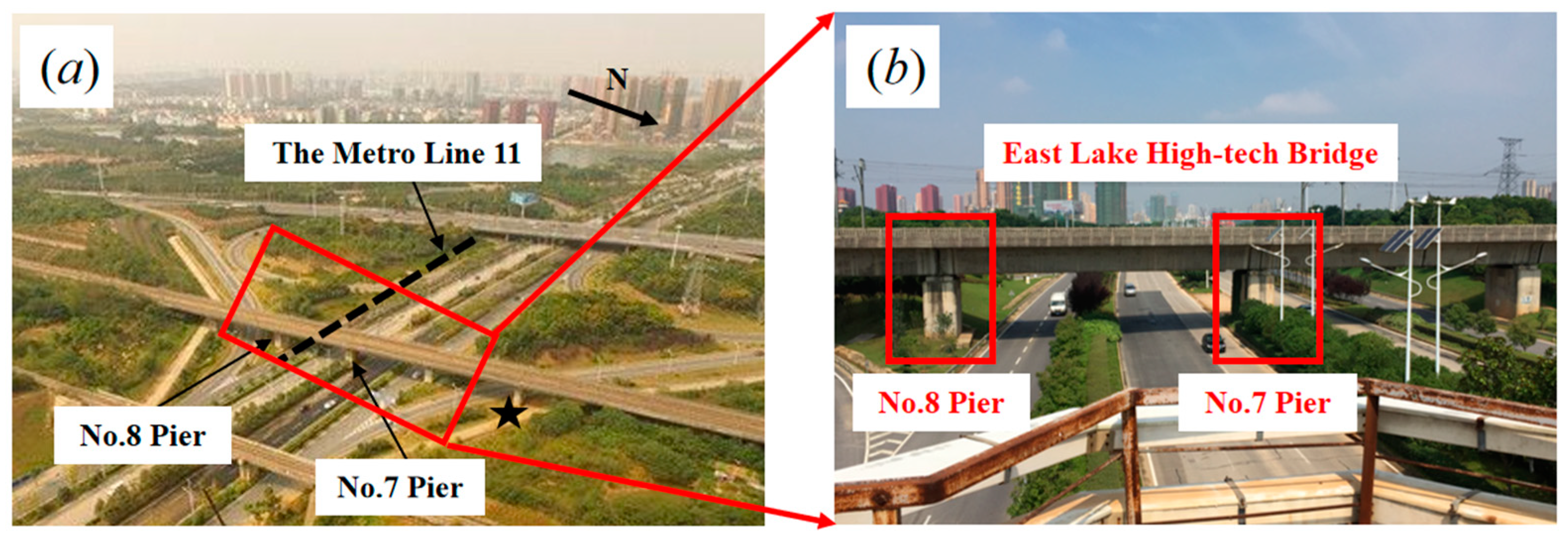
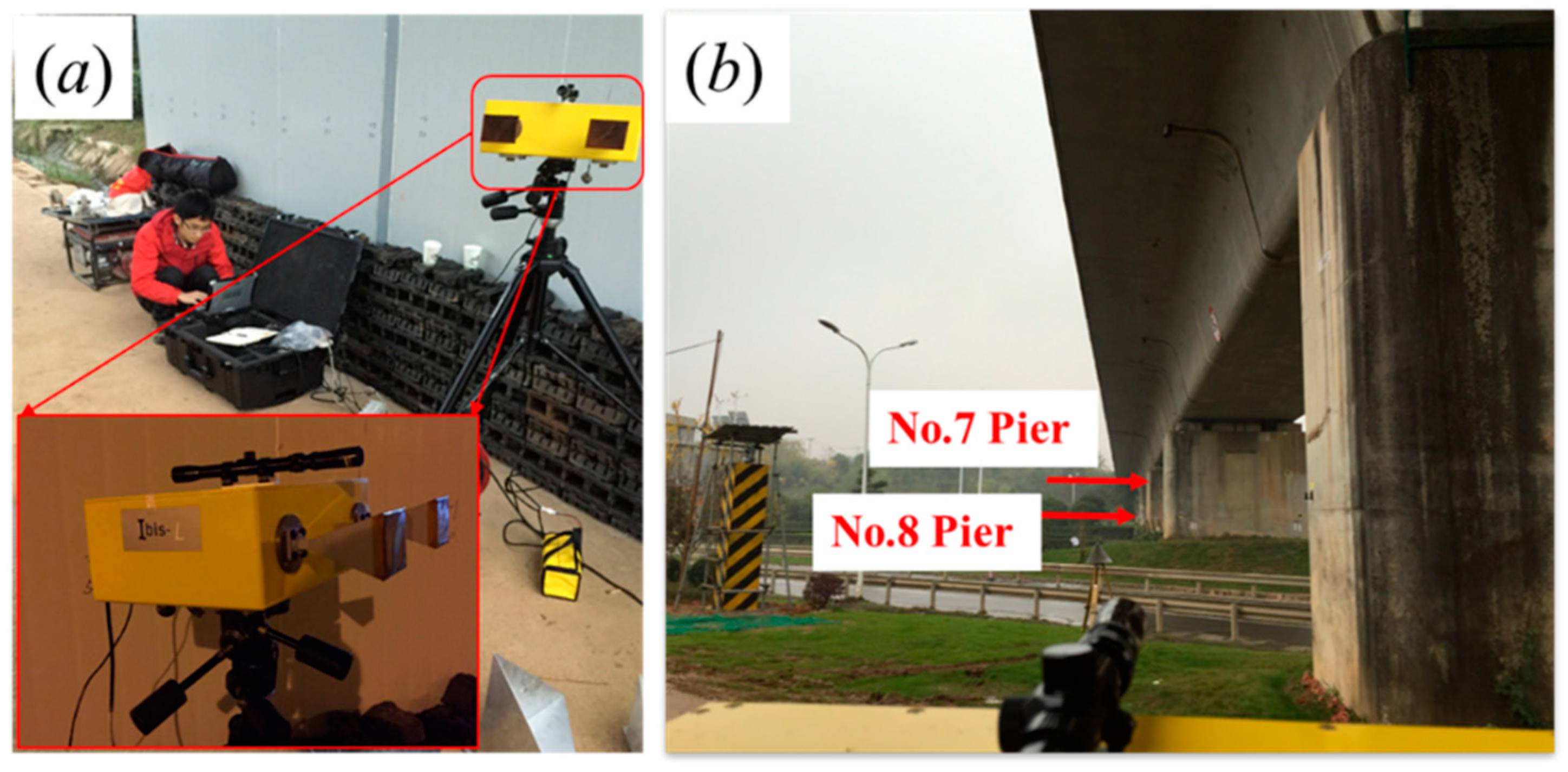
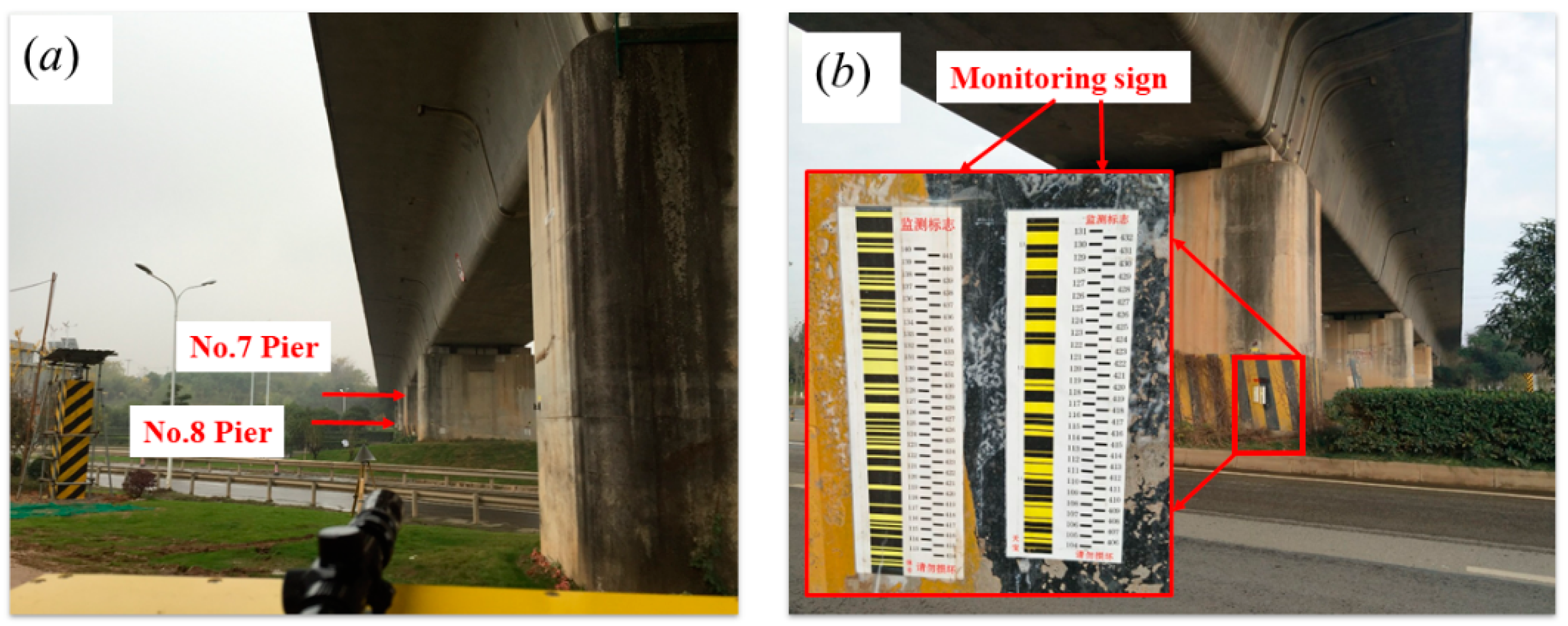
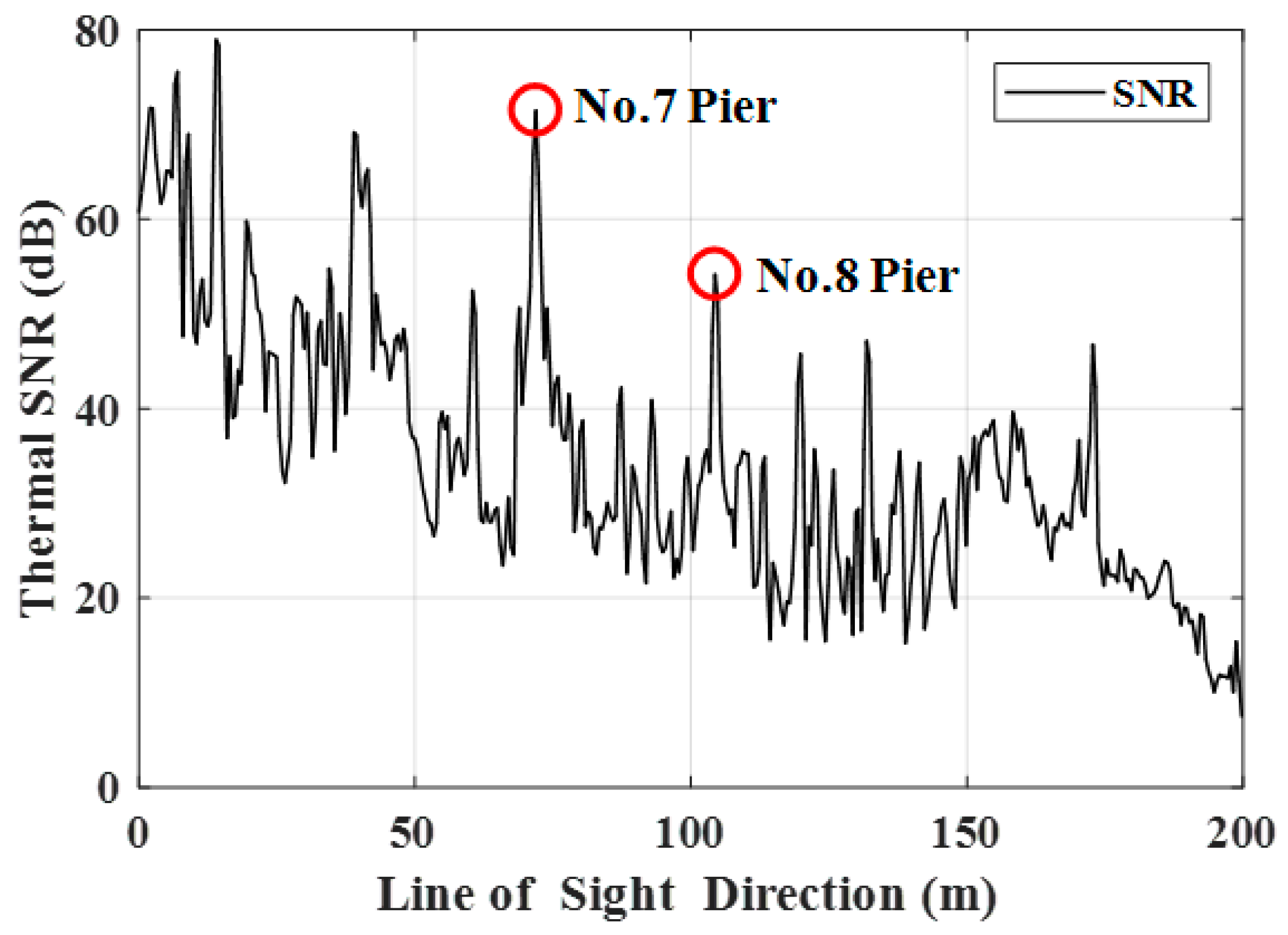
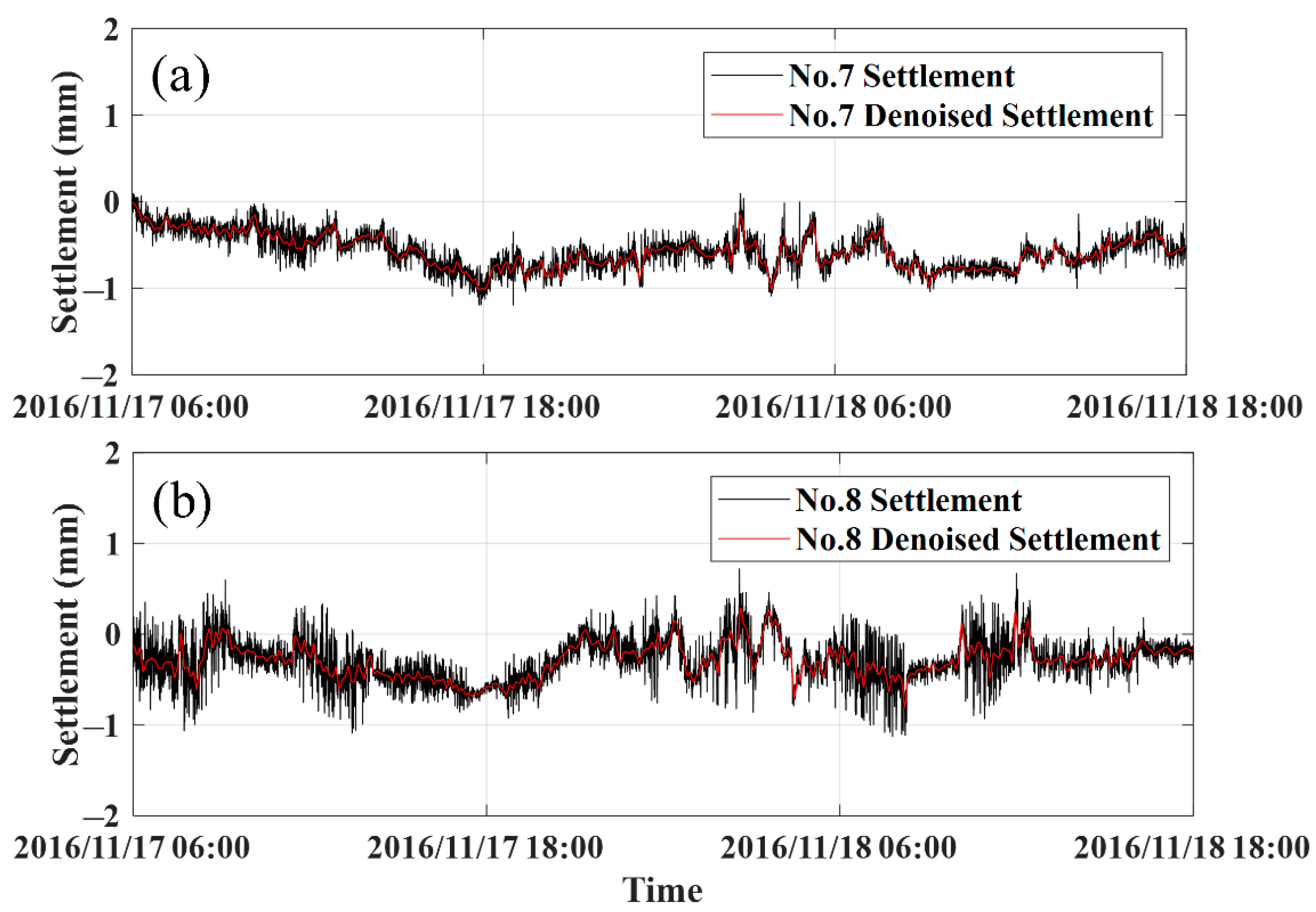
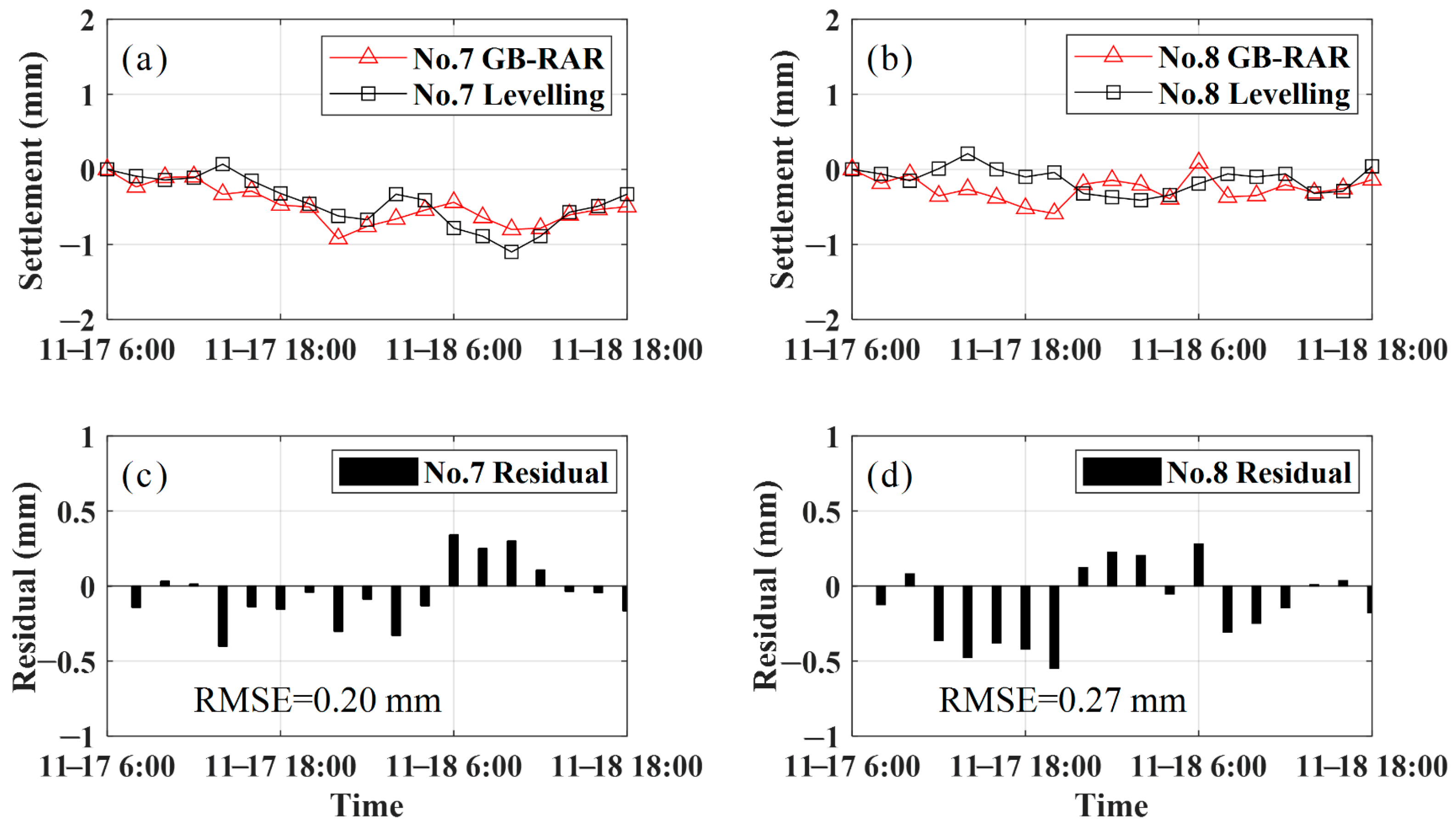

| Parameter | Description |
|---|---|
| Radar type | FMCW |
| Bandwidth | 200 MHz |
| Frequency range | 17.1–17.3 GHz (Ku band) |
| Radar antenna inclination | 10° |
| Observation distance | 200 m |
| Range resolution | 0.5 m |
| Sampling frequency | 20 Hz |
| Start time | 17 November 2016 06:00 |
| End time | 18 November 2016 18:00 |
| Method | Time Span | Settlement Rates and Uncertainties (mm/h) | |
|---|---|---|---|
| No. 7 Pier | No. 8 Pier | ||
| GB-RAR Deformation Information Estimation Method Considering the Influence of Colored Noise | 2016.11.17 | −0.0315 ± 0.0053 | −0.0210 ± 0.0085 |
| 2016.11.18 | −0.0145 ± 0.0059 | −0.0000 ± 0.0125 | |
| 2016.11.17–18 | −0.0112 ± 0.0026 | −0.0046 ± 0.0053 | |
| GB-RAR Deformation Information Estimation Method without Considering the Influence of Colored Noise | 2016.11.17 | −0.0270 ± 0.0007 | −0.0197 ± 0.0007 |
| 2016.11.18 | −0.0099 ± 0.0007 | −0.0007 ± 0.0007 | |
| 2016.11.17–18 | −0.0145 ± ≪10−4 | −0.0013 ± ≪10−4 | |
| Leveling | 2016.11.17 | −0.0055 ± 0.0650 | −0.0140 ± 0.0360 |
| 2016.11.18 | 0.0108 ± 0.0755 | 0.0079 ± 0.0408 | |
| 2016.11.17–18 | −0.0107 ± 0.0110 | −0.0089 ± 0.0641 | |
Publisher’s Note: MDPI stays neutral with regard to jurisdictional claims in published maps and institutional affiliations. |
© 2022 by the authors. Licensee MDPI, Basel, Switzerland. This article is an open access article distributed under the terms and conditions of the Creative Commons Attribution (CC BY) license (https://creativecommons.org/licenses/by/4.0/).
Share and Cite
Wang, C.; Zhou, L.; Ma, J.; Shi, A.; Li, X.; Liu, L.; Zhang, Z.; Zhang, D. GB-RAR Deformation Information Estimation of High-Speed Railway Bridge in Consideration of the Effects of Colored Noise. Appl. Sci. 2022, 12, 10504. https://doi.org/10.3390/app122010504
Wang C, Zhou L, Ma J, Shi A, Li X, Liu L, Zhang Z, Zhang D. GB-RAR Deformation Information Estimation of High-Speed Railway Bridge in Consideration of the Effects of Colored Noise. Applied Sciences. 2022; 12(20):10504. https://doi.org/10.3390/app122010504
Chicago/Turabian StyleWang, Cheng, Lv Zhou, Jun Ma, Anping Shi, Xinyi Li, Lilong Liu, Zhi Zhang, and Di Zhang. 2022. "GB-RAR Deformation Information Estimation of High-Speed Railway Bridge in Consideration of the Effects of Colored Noise" Applied Sciences 12, no. 20: 10504. https://doi.org/10.3390/app122010504
APA StyleWang, C., Zhou, L., Ma, J., Shi, A., Li, X., Liu, L., Zhang, Z., & Zhang, D. (2022). GB-RAR Deformation Information Estimation of High-Speed Railway Bridge in Consideration of the Effects of Colored Noise. Applied Sciences, 12(20), 10504. https://doi.org/10.3390/app122010504








